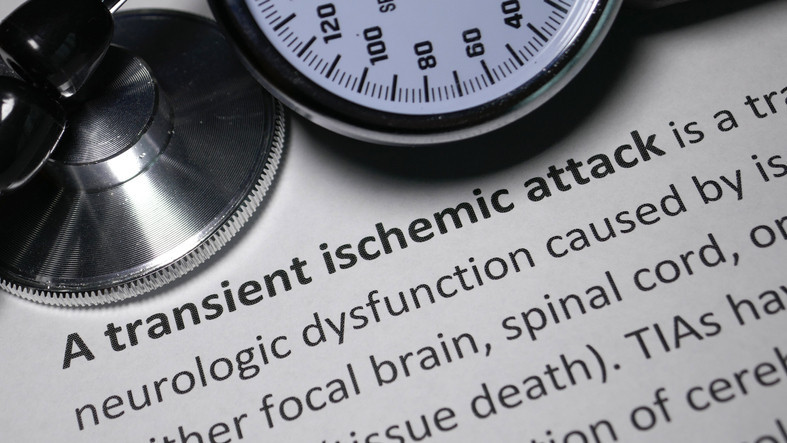Transient ischemic attacks: Varied symptoms, all important

Often called a ministroke, a transient ischemic attack (TIA) is a temporary change in nerve function caused by a disruption in blood flow to an area of the brain or spinal cord. Much as with an actual stroke, this may affect speech, vision, or movement for a few moments to a few hours, though always for less than 24 hours. Because a TIA is temporary, it does not lead to permanent effects. And typically, it doesn't leave a permanent scar in the brain. Calling this a ministroke is misleading: while its symptoms may be anything but "mini," the result usually is a warning sign rather than a stroke.
Many people may recognize classical signs of a TIA. However, recent research suggests that less common symptoms may go unnoticed. That's unfortunate, because a TIA is an important sign that all is not right with the brain's health. Experiencing one increases a person's risk of having a permanent stroke in the near future — possibly within the next several days. So, knowing the broader range of possible TIA symptoms could help you or a loved one recognize a major risk factor for an upcoming stroke. Your health care provider can then advise you on whether you need follow-up tests and, if necessary, start you on treatment to reduce elevated stroke risk.
What are the classical symptoms of a TIA?
Because different areas of the brain have different tasks, the symptoms that occur during a TIA depend on the part of the brain in which blood flow is disrupted. Sudden muscle weakness, speech changes, and changes in vision in one or both eyes are classical TIA symptoms.
An easy way to remember this is the memory-jogging phrase BE-FAST that tells people what to look for and do in case of a stroke or TIA. Sudden changes with Balance or Eyes (vision), Face asymmetry, Arm weakness, or Speech changes mean it's Time to call 911.
It's more difficult to attribute other, less specific symptoms — such as dizziness, double vision, or numbness or sensory changes like tingling or "pins and needles" — solely to a disruption in blood flow. So, symptoms like these may be ascribed to another cause, or simply ignored by many people and even by health care providers. And that may mean we're missing some opportunities to identify and treat people who experience a broader range of symptoms suggesting a possible TIA.
Which additional symptoms might be important signs of a TIA?
A study published in Lancet addresses this question. Using data from participants in the Oxford Vascular Study (OXVASC), the researchers first defined the signs of "classical" TIAs as temporary- weakness that affects balance, gait, or ability to move part of the body, such as an arm or leg (motor weakness)
- trouble speaking or understanding speech (dysphasia)
- partial loss of vision in both eyes (hemianopia or quadrantanopia)
- loss of vision in just one eye (monocular vision loss).
- dizziness with no other symptoms
- thick or slurred speech
- abnormal or clumsy gait
- double vision or loss of vision in both eyes
- numbness in one segment of the body, including face, arm, or leg.
Who sought medical advice or care — and who didn't?
Using these criteria, the researchers identified 1,021 participants with classical TIAs, and 570 participants with nonconsensus TIAs.
People in the nonconsensus TIA group were less likely to seek medical care on the day of symptoms than those with classical TIAs (59% versus 75%). And they were more likely to wait more than three days to seek medical care (34% versus 17%).
However, the risk of having a stroke during the 90-day period after having classical or nonconsensus TIA symptoms was similar in both groups: 10.6% and 11.6%, respectively. Unfortunately, by the time they sought care, 8% of nonconsensus TIA participants had already had a permanent stroke, compared to 5% of classical TIA participants. It's likely this reflects lower perceived urgency for seeking medical care.
The bottom line
Pay attention to all possible symptoms of a TIA. If you think you might be having one, call 911 or go to a hospital for immediate evaluation. If you're not certain, but you have some of the less classical symptoms described above, call your health care provider immediately for advice or go to the hospital. You may need tests or an exam and follow-up care, possibly including medicines that could help prevent a stroke.About the Author

Christopher D. Anderson, MD, MSc, Contributor
Disclaimer:
As a service to our readers, Harvard Health Publishing provides access to our library of archived content. Please note the date of last review or update on all articles.
No content on this site, regardless of date, should ever be used as a substitute for direct medical advice from your doctor or other qualified clinician.















